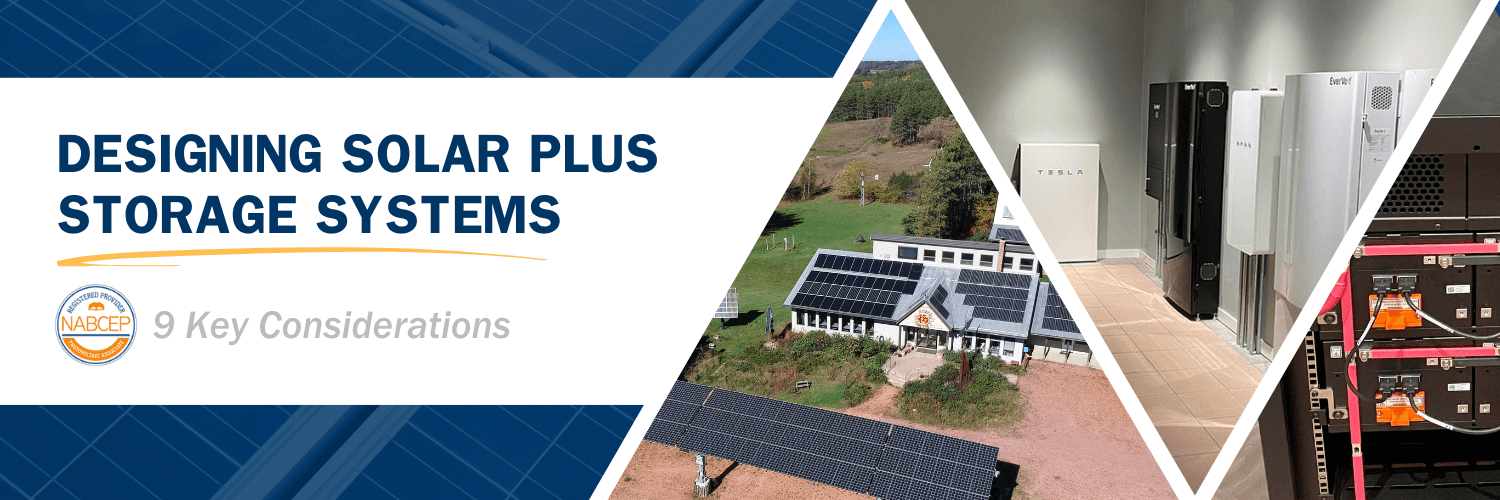If you or your customers are looking to make your home or business more energy-efficient, combining solar energy with battery storage might be the solution you need. Not only does it offer backup power during outages, but it also helps you save money and reduce your reliance on the grid. Designing a system that works just right for your needs requires some planning and expertise.
At the Midwest Renewable Energy Association (MREA), we offer online and in-person NABCEP-approved training courses that teach you everything you need to know about designing, installing, and maintaining solar plus storage systems. Whether you’re a beginner or an experienced installer looking to expand your knowledge, our courses will equip you with the skills to succeed.
Let’s dive into 9 key considerations for designing solar plus storage systems, and see how MREA can help you understand them.

1. Understanding Your Energy Use: Saving Money and Energy
Before designing a system, it’s important to understand how and when you use energy. This is where understanding your energy consumption patterns comes in. For example, if you use more energy during the evening when electricity rates are higher, a battery storage system can help. You can store solar power during the day when it’s cheaper and use it during the more expensive peak hours. This helps lower your energy bills and maximizes your system’s potential.
2. Maximizing Efficiency: Getting the Most Out of Your System
All energy systems experience some level of energy loss—whether it’s in the solar panels or the battery. For example, when you store energy in a battery, you won’t get back the full amount you put in. Most lithium-ion batteries offer about 85-95% efficiency, meaning some energy is lost during charging and discharging.
3. Grid-Tied or Off-Grid: What’s Best for You?
One of the first things to figure out is whether your system will be grid-tied or off-grid. If you’re grid-tied, your system’s main job is to provide backup power during outages and reduce costs by avoiding peak demand charges. If you’re off-grid, you’ll need to make sure your battery is large enough to power your home or business entirely when the sun isn’t shining.
4. Choosing the Right Battery: Lifespan and Cost
Not all batteries are created equal. Lithium-ion batteries tend to be more efficient and last longer (around 10-15 years), but they come with a higher upfront cost. Lead-acid batteries, on the other hand, are cheaper but have a shorter lifespan and need to be replaced more often.
5. Load Analysis: What Needs Power the Most?
When designing your system, it’s important to know what parts of your home or business are critical loads—the things that need to keep running during a power outage, like your fridge or essential lights. For businesses, demand charges can significantly increase your electricity costs. A storage system can help reduce those charges by using stored energy during peak hours instead of drawing from the grid.
6. Sizing Your Solar System: Get the Right Fit
Getting the right size solar system is crucial. You need to account for factors like solar irradiance (how much sunlight your area receives) and shading, which can affect how much energy your panels produce. If you generate more energy than you need, you can store excess energy in a battery instead of sending it to the grid—depending on your local utility’s net metering policies.
7. Backup Power: Be Ready for Emergencies
One of the biggest advantages of having battery storage is that it provides backup power during power outages. If you live in an area prone to severe weather like hurricanes or snowstorms, having a reliable backup system is essential. Choosing the right battery size and inverter is key to ensuring you can keep critical devices running when the grid goes down.
8. Financial Considerations: How to Make It Work for Your Budget
The initial cost of installing solar plus storage can be high, but there are many financial incentives—like tax credits, rebates, and other programs—that can help offset the cost. Plus, with the right system, you can save money on your energy bills over time. It’s important to figure out how long it will take for your system to pay for itself.
9. Ongoing Maintenance: Keep Your System Running Smoothly
Once your system is installed, it’s important to monitor its performance regularly. While solar systems generally require little maintenance, it’s still a good idea to keep track of how your battery and panels are doing. By using monitoring tools, you can identify issues early and keep your system running efficiently.
Explore our energy storage training and resources!
Start Learning!
Join us for Solar Plus Storage Training!
If you’re ready to dive into the world of solar plus storage, MREA offers online and in-person courses to give you the knowledge and hands-on experience you need. Our courses cover everything from the basics to advanced design, installation, and maintenance techniques. Whether you’re just starting out or looking to expand your expertise, MREA’s courses are the perfect way to get the skills you need to succeed in the growing field of renewable energy.

Our solar plus storage courses are approved for NABCEP Continuing Education Credits (CECs) and students can take these courses to work toward the requirements for the Energy Storage Installation Professional (ESIP) board certification.


